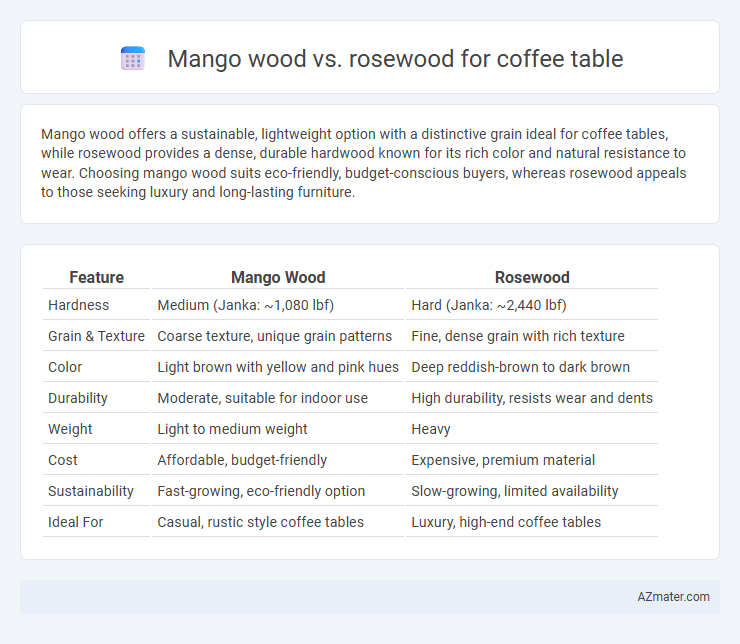Mango wood offers a sustainable, lightweight option with a distinctive grain ideal for coffee tables, while rosewood provides a dense, durable hardwood known for its rich color and natural resistance to wear. Choosing mango wood suits eco-friendly, budget-conscious buyers, whereas rosewood appeals to those seeking luxury and long-lasting furniture.
Table of Comparison
| Feature | Mango Wood | Rosewood |
|---|---|---|
| Hardness | Medium (Janka: ~1,080 lbf) | Hard (Janka: ~2,440 lbf) |
| Grain & Texture | Coarse texture, unique grain patterns | Fine, dense grain with rich texture |
| Color | Light brown with yellow and pink hues | Deep reddish-brown to dark brown |
| Durability | Moderate, suitable for indoor use | High durability, resists wear and dents |
| Weight | Light to medium weight | Heavy |
| Cost | Affordable, budget-friendly | Expensive, premium material |
| Sustainability | Fast-growing, eco-friendly option | Slow-growing, limited availability |
| Ideal For | Casual, rustic style coffee tables | Luxury, high-end coffee tables |
Introduction to Mango Wood and Rosewood
Mango wood is a sustainable hardwood known for its durability, unique grain patterns, and cost-effectiveness, making it a popular choice for coffee tables. Rosewood, prized for its rich color, dense texture, and natural oils, offers exceptional strength and a luxurious finish that enhances furniture longevity. Both woods provide distinct aesthetic appeal and functional benefits, with mango wood emphasizing eco-friendliness and affordability, while rosewood highlights elegance and durability.
Appearance and Grain Differences
Mango wood features a light, golden-yellow to brown color with a subtle grain pattern that often includes occasional knots and streaks, giving a rustic and natural appearance ideal for casual coffee tables. Rosewood, on the other hand, is known for its rich, dark reddish-brown hues with pronounced, intricate grain patterns and a smooth, polished finish, providing an elegant and sophisticated look. The contrasting appearance and grain complexity make mango wood suitable for a warm, organic style, while rosewood enhances luxurious, high-end furniture aesthetics.
Durability and Strength Comparison
Mango wood offers moderate durability and is lightweight, making it suitable for coffee tables with regular use, but it is less dense compared to rosewood. Rosewood is renowned for its exceptional hardness, high density, and superior strength, providing excellent resistance to scratches and dents for long-lasting coffee tables. The natural oils in rosewood enhance its durability and moisture resistance, giving it an edge over mango wood in terms of strength and longevity.
Sustainability and Environmental Impact
Mango wood, harvested from sustainable and fast-growing mango trees, offers an eco-friendly alternative to rosewood, which is often sourced from slower-growing, endangered trees subject to illegal logging. The use of mango wood promotes responsible forestry practices and reduces deforestation, while rosewood's high demand contributes to significant habitat loss and biodiversity threats. Choosing mango wood for coffee tables supports sustainability by utilizing a renewable resource with a lower environmental footprint.
Cost and Affordability
Mango wood offers a cost-effective and affordable option for coffee tables, providing durability and a unique grain pattern at a lower price point compared to rosewood. Rosewood, known for its rich color and luxurious finish, tends to be significantly more expensive due to its rarity and high demand in fine furniture. Choosing mango wood coffee tables balances budget constraints with aesthetic appeal, while rosewood caters to premium, high-end preferences.
Maintenance and Care Requirements
Mango wood requires regular oiling to maintain its natural luster and prevent drying, with occasional dusting and wiping using a damp cloth to avoid scratches and stains. Rosewood is denser and more durable, needing less frequent maintenance but benefits from periodic polishing to preserve its rich color and grain pattern. Both woods should be kept away from direct sunlight and moisture to prevent warping and discoloration, ensuring longevity for coffee tables.
Suitability for Coffee Table Use
Mango wood offers excellent durability and resistance to wear, making it a practical choice for coffee tables subjected to daily use. Rosewood, known for its rich grain and hardness, provides superior strength and aesthetic appeal but at a higher cost and maintenance level. Both woods are suitable for coffee tables, with mango wood excelling in affordability and sustainability, while rosewood delivers premium elegance and longevity.
Popular Styles and Finishes
Mango wood coffee tables often showcase rustic and farmhouse styles, prized for their natural grain and warm honey hues that complement matte or satin finishes. Rosewood tables lean toward elegant and traditional designs, featuring deep reddish-brown tones with intricate grain patterns enhanced by high-gloss or polished finishes. Both woods offer durable surfaces, but mango's accentuated textures suit casual interiors, while rosewood's rich luster fits formal settings.
Pros and Cons of Mango Wood Coffee Tables
Mango wood coffee tables offer durability, a unique grain pattern, and eco-friendliness due to their sustainable sourcing, making them a popular choice for environmentally conscious buyers. However, mango wood is softer than rosewood, which may result in more scratches and dents over time, and its lighter color may show stains more easily. Rosewood coffee tables are harder and more resistant to wear, but they tend to be more expensive and less sustainable compared to mango wood.
Pros and Cons of Rosewood Coffee Tables
Rosewood coffee tables are prized for their rich, dark hues and natural durability, offering a luxurious and long-lasting centerpiece with high resistance to scratches and dents. However, rosewood tends to be more expensive and heavier than other woods like mango, requiring careful maintenance to prevent cracking or warping over time. The wood's limited availability raises environmental concerns, making sustainably sourced options essential for eco-conscious buyers.

Infographic: Mango wood vs Rosewood for Coffee Table
 azmater.com
azmater.com